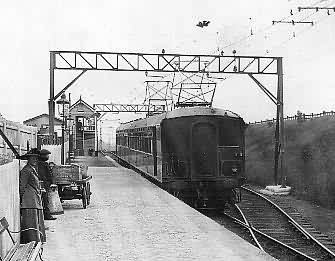
Suburban Electric Railway Association
Located at the COVENTRY ELECTRIC RAILWAY CENTRE, Rowley Road, Baginton, Warwickshire
Established
1996
The History Zone
The Electric Railways Of Manchester
Part One
Manchester is one of the UK's largest cities, and as such has since the industrial revolution been a developing centre for both industry and commerce. It was only natural that such a location would boast a sizeable suburban railway network, and of course it was inevitable that the various railway companies that ran these services would want to exploit the advantages that the advent of electric traction could bring. The story of how commuters into and out of the manchester area came to travel on trains 'powered by lightning' is a complex story; a brief explanation follows in a route by route format.
Routes To Bury
The first use of electric traction in the Manchester area was an experimental scheme for the Lancashire & Yorkshire Railway on the three and three quarter mile long line from Bury to Holcombe Brook. The scheme was paid for by the Dick, Kerr Company of Preston as they needed to demonstrate their electric traction supply and motive power equipment in the hope of winning a huge order from Brazil. The route was electrified with overhead wires energised at 3,500vDC and two trains were built to operate the passenger service at the L&Y works at Newton Heath. Both cars had a cab at their outer end and a pantogragh for current collection, but only one carried the four Dick Kerr traction motors and control equipment. A ten minute interval service on the line could be maintained by the use of only one set. One of the units is pictured on the below at Holcombe Brook station in 1913.
The service ran in this format from 1912 to 1917. Dick, Kerr & Co. did not win the brazilian contract but as a result of this scheme had assured themselves of further electrification contracts from the L & Y when they decided to electrify their commuter line from Manchester Victoria to Bury in 1914.
The Bury route had seen considerable expansion in the years prior to the Great War and the L & Y saw electrification as a way of attracting new patronage to their services. The system chosen for this route was a 1200vDC side contact third rail, whereby the collector shoe rather that brushing against the top of the energised rail ran in a trough at the side and brushed the outer edge of the rail to collect current.
Electric services began on the nine and a half mile route in late 1915, with the line from Bury to Holcombe Brook converted to the same system to permit through running from March 1918. In reality most services terminated at Bury with a shuttle service onward for Holcombe Brook. The units built for the new service were similar to those for the Holcombe Brook trials and were again built by the L & Y at Newton Heath with electrical equipment from Dick, Kerr & Company. The cars were of all metal construction with steel under and body frames with aluminium body panels, like the experimental sets there were two types of car, a driving motor and a driving trailer. The journey time from manchester victoria to Bury was 24 minutes as opposed to 32 minutes by the previous steam service.
The L & Y units lasted in service until 1959 when they were finally replace by British Rail built two car sets assembled at Wolverton. These units consisted of a driving trailer and a driving motor brake. The bodyshell was of the standard BR suburban coach with a door to every seating bay, however the front of the cab was a new departure as it featured a sloping front which was to become a feature of all Wolverton Built EMUs.
These units continued to serve the Victoria - Bury route (but not the one to Holcombe Brook as it was de-electrified and closed in 1951) until 1991 when the whole of the route was absorbed into the Manchester Metrolink scheme.




